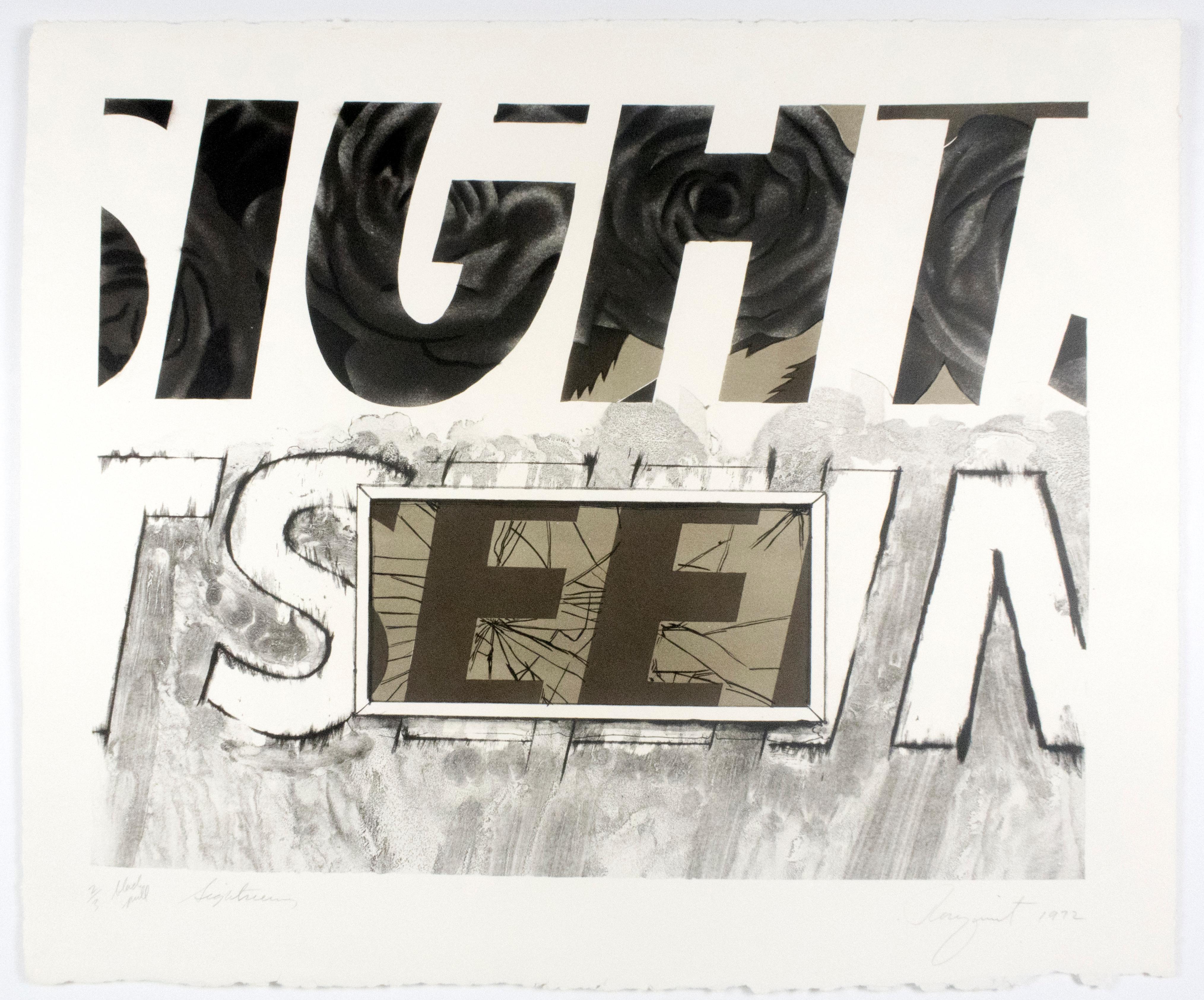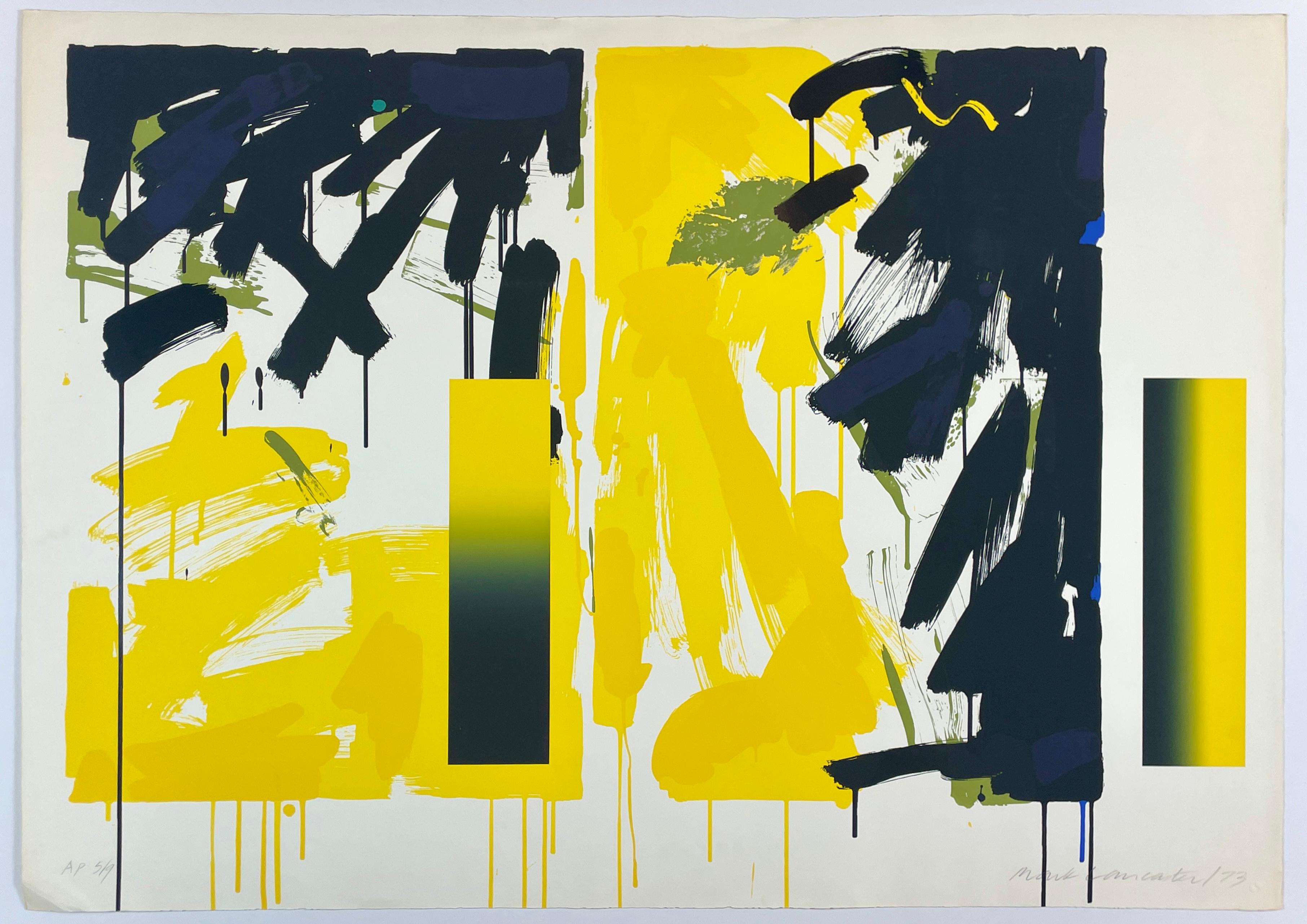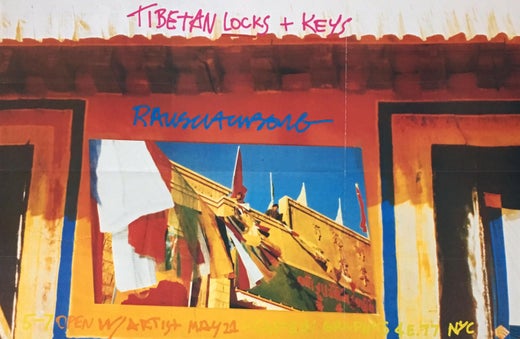Robert RauschenbergWhy can't you tell1979
1979
About the Item
- Creator:Robert Rauschenberg (1925 - 2008, American)
- Creation Year:1979
- Dimensions:Height: 38.75 in (98.43 cm)Width: 31.5 in (80.01 cm)Depth: 1.35 in (3.43 cm)
- Medium:
- Movement & Style:
- Period:
- Condition:
- Gallery Location:San Francisco, CA
- Reference Number:
Robert Rauschenberg
Robert Rauschenberg was one of the preeminent American artists of the 20th century, occupying a singular position that straddled the Abstract Expressionist and Pop art movements, drawing on key elements of each. An artistic polymath equally adept at painting, collage and silkscreening, Rauschenberg is best known for for the complex assemblages of found objects he termed “combines.”
Rauschenberg was born in Port Arthur, Texas, in 1925. He first began to seriously consider a career in art in 1947, while serving in the U.S. Marines. After leaving the service, he briefly studied art in Paris with support from the G.I. Bill, then moved to North Carolina to attend Black Mountain College, home to a flourishing cross-disciplinary art community. Among his peers there were choreographer Merce Cunningham and composer John Cage, both of whom became friends and artistic collaborators.
Relocating to New York in the mid-1950s, Rauschenberg was initially put off by what he perceived as the self-seriousness of the adherents of Abstract Expressionism, then the dominant movement in the New York art world. Like Andy Warhol and Roy Lichtenstein, Rauschenberg was drawn to the visual landscape of popular culture and mined its imagery for inspiration. He used unorthodox materials like house paint and tried novel techniques in his studio like running paper over with a car whose wheels he had inked. Shortly after his inaugural solo exhibition at Leo Castelli Gallery, which featured paintings and drawings, he pivoted to a new format, creating his first found-object combines, which became his signature. The most famous of these is the 1959 Monogram in which a taxidermied goat is surrounded by a car tire, recalling the way a person’s initials are interwoven in the design referred to by the title.
Later in the 1960s, Rauschenberg turned his attention to silkscreening, creating prints that feature iconic figures of the day, very much in line with the style and content of Pop art. One such work, 1965's Core, which was created to commemorate the Congress of Racial Equality, combines photographs of President Kennedy, an unidentified Native American man, and a statue of a Civil War soldier with images of highways, amusement parks, street signs, and other features of the built environment. A circular color-test wheel sits at the composition’s formal core, reflecting the work’s commentary on race and ethnicity.
Throughout the 1960s and ‘70s, Rauschenberg experimented with printing on unusual materials, such as Plexiglas, clothing and aluminum. Venturing even further afield, he created performance works, such as his 1963 choreographed piece “Pelican” and the 1966 film Open Score. In 1998, the Guggenheim Museum presented a large and comprehensive retrospective of Rauschenberg’s work, highlighting his influence on American art in the second half of the 20th century.
Find original Robert Rauschenberg art for sale on 1stDibs.
- ShippingRetrieving quote...Ships From: San Francisco, CA
- Return PolicyA return for this item may be initiated within 7 days of delivery.
- Landscape 1 from 11 Pop Artists SeriesBy Allan D'Arcangelo 1Located in San Francisco, CAThis artwork titled "Landscape 1 from 11 Pop Artists Series" is an original screen print by American artist Allan D'Arcangelo, 1930-1998. It is signed,...Category
Late 20th Century Pop Art Abstract Prints
MaterialsScreen
- Darryl Pottorf Exceptional Print – Truck Stop de Marra KechBy Darryl PottorfLocated in San Francisco, CAThis impressive 12 color screenprint is by Darryl Pottorf (1952- ) The print is titled “Truck Stop de Marra Kech”. It was printed and published in 2000 by Gemini G.E.L. the well-kno...Category
Early 2000s Pop Art Abstract Prints
MaterialsScreen
- "Wrapped Statues, Aegina Temple" Large screen print with collage.Located in San Francisco, CAThis artwork titled "Wrapped Statues, Aegina Temple, Project for the Munich Glyptotek" from the "Official Arts Portfolio of the XXIV Olympic" 1988, is an original screen print with c...Category
Late 20th Century Pop Art Abstract Prints
MaterialsScreen
- Gloster Heming, Vote For WomenBy Robert IndianaLocated in San Francisco, CAArtist: Robert Indiana (American, born 1928) Title: Gloster Heming, Vote For Women Year: 1977 Medium: Color lithograph Edition: Numbered 67/150 in penci...Category
1970s Pop Art Abstract Prints
MaterialsLithograph
- Why You Can Tell #2By Robert RauschenbergLocated in San Francisco, CAThis artwork titled "Why You Can Tell #2" from the suite "Nine Prints" is an original serigraph with offset lithograph and collage on Wove paper by American artist Robert Rauschenberg, 1925-2008. It is hand signed and numbered 36/100 in pencil by the artist. Published by Multiples, New York and Printed by Styria Studio, New York. With the blind stamp of the printer at lower left corner. The sheet size is 22.75 x 30 inches, framed is 43 x 34.25 inches. This particular artwork is held in several museums, including the Museum of Modern Art, New York. It is beautifully framed in a wooden gold frame, with fabric matting and color bevel. About the artist. Born in Port Arthur, Texas in 1925, Robert Rauschenberg imagined himself first as a minister and later as a pharmacist. It wasn't until 1947, while in the U.S. Marines, that he discovered his aptitude for drawing and his interest in the artistic representation of everyday objects and people. After leaving the Marines, he studied art in Paris on the G.I. Bill, but quickly became disenchanted with the European art scene. Rauschenberg's enthusiasm for popular culture and his rejection of the angst and seriousness of the Abstract Expressionists led him to search for a new way of painting. He found his signature mode by embracing materials traditionally outside of the artist's reach. He would cover a canvas with house paint, or ink the wheel of a car and run it over paper to create a drawing, while demonstrating rigor and concern for formal painting. By 1958, at the time of his first solo exhibition at the Leo Castelli Gallery, his work had moved from abstract painting to drawings like "Erased De Kooning" (1953) (which was exactly as it sounds) to what he termed "combines." These combines (meant to express both the finding and forming of combinations in three-dimensional collage) cemented his place in art history. As Pop Art emerged in the 1960s, Rauschenberg turned away from three-dimensional combines and began to work in two dimensions, using magazine...Category
Late 20th Century Pop Art Abstract Prints
MaterialsMixed Media
- FlyBy James RosenquistLocated in San Francisco, CAThis artwork titled "Fly" 1981 is an original color lithograph on Arches paper by renown American artist James Rosenquist, 1933-2017. It is hand signed, dated, titled and numbered P....Category
Late 20th Century Pop Art Abstract Prints
MaterialsLithograph
- "Moi je veux vivre monotone" by Patrick Caulfield, Screenprint, Pop Art, PurpleBy Patrick CaulfieldLocated in Köln, DE"Moi je veux vivre monotone" is from the series "Some poems by Jules Laforgue". Patrick Caulfied was deeply inspired by these poems and found to his very own depiction of these poems...Category
1970s Pop Art Abstract Prints
MaterialsScreen
- "New York City Center 25th Anniversary"By Robert IndianaLocated in New York, NYRobert Indiana "New York City Center 25th Anniversary" New York City Center, 1968 Silkscreen Poster 35 x 25 inches Unsigned This poster is printed on...Category
1960s Pop Art Abstract Prints
MaterialsScreen
- Man Powered Airplane Solomon (Jun Rope)By Yokoo TadanoriLocated in New York, NYTadanori Yokoo Man Powered Airplane Solomon (Jun Rope), 1967 Silkscreen poster 41 x 29 inches (image) 44 1/4 x 32 1/2 x 1 1/2 inches (frame) Signed and stamped with Artist's seal Wh...Category
1970s Pop Art Abstract Prints
MaterialsScreen
- Polygon: Square (Four) /// Pop Art Robert Indiana Screenprint New York NumbersBy Robert IndianaLocated in Saint Augustine, FLArtist: Robert Indiana (American, 1928-2018) Title: "Polygon: Square (Four)" Portfolio: The American Dream *Issued unsigned Year: 1997 Medium: Original Screenprint on Coventry paper...Category
1990s Pop Art Abstract Prints
MaterialsScreen
- Sightseeing (black pull) James Rosenquist text Pop Art in black and whiteBy James RosenquistLocated in New York, NYThis abstract composition features a cropped view of the words SIGHT SEEING, in bold all-capital lettering. Roses fill the top line of text, and the bottom line of text in white is s...Category
1970s Pop Art Abstract Prints
MaterialsLithograph, Screen
- 1973 by Mark Lancaster Neon yellow and black British pop art graffitiLocated in New York, NYA dynamic neon-yellow and black Mark Lancaster screen print combining calligraphic paint strokes, paint drips, and smooth, graphic yellow gradients characteristic of the artist's mos...Category
1970s Pop Art More Prints
MaterialsScreen





